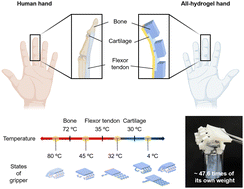Human hand-inspired all-hydrogel gripper with a high load capacity formed by the split-brushing adhesion of diverse hydrogels†
Abstract
Human hands are highly versatile. Even though they are primarily made of materials with high water content, they exhibit a high load capacity. However, existing hydrogel grippers do not possess a high load capacity due to their innate softness and mechanical strength. This work demonstrates a human hand-inspired all-hydrogel gripper that can bear more than 47.6 times its own weight. This gripper is made of two hydrogels: poly(methacrylamide-co-methacrylic acid) (P(MAAm-co-MAAc)) and poly(N-isopropylacrylamide) (PNIPAM). P(MAAm-co-MAAc) is extremely stiff but becomes soft above its transition temperature. By taking advantage of the difference in the kinetics of the stiff–soft transition of P(MAAm-co-MAAc) hydrogels and the swelling–shrinking transition of PNIPAM hydrogels, this gripper can be switched between its stiff-bent and stiff-stretched states by simply changing the temperature. The assembly of these two hydrogels into a gripper necessitated the development of a new hydrogel adhesion method, as existing topological adhesion methods are not applicable to such stiff hydrogels. A new hydrogel adhesion method, termed split-brushing adhesion, has been demonstrated to satisfy this need. When applied to P(MAAm-co-MAAc) hydrogels, this method achieves an adhesion energy of 1221.6 J m−2, which is 67.5 times higher than that achieved with other topological adhesion methods.



 Please wait while we load your content...
Please wait while we load your content...